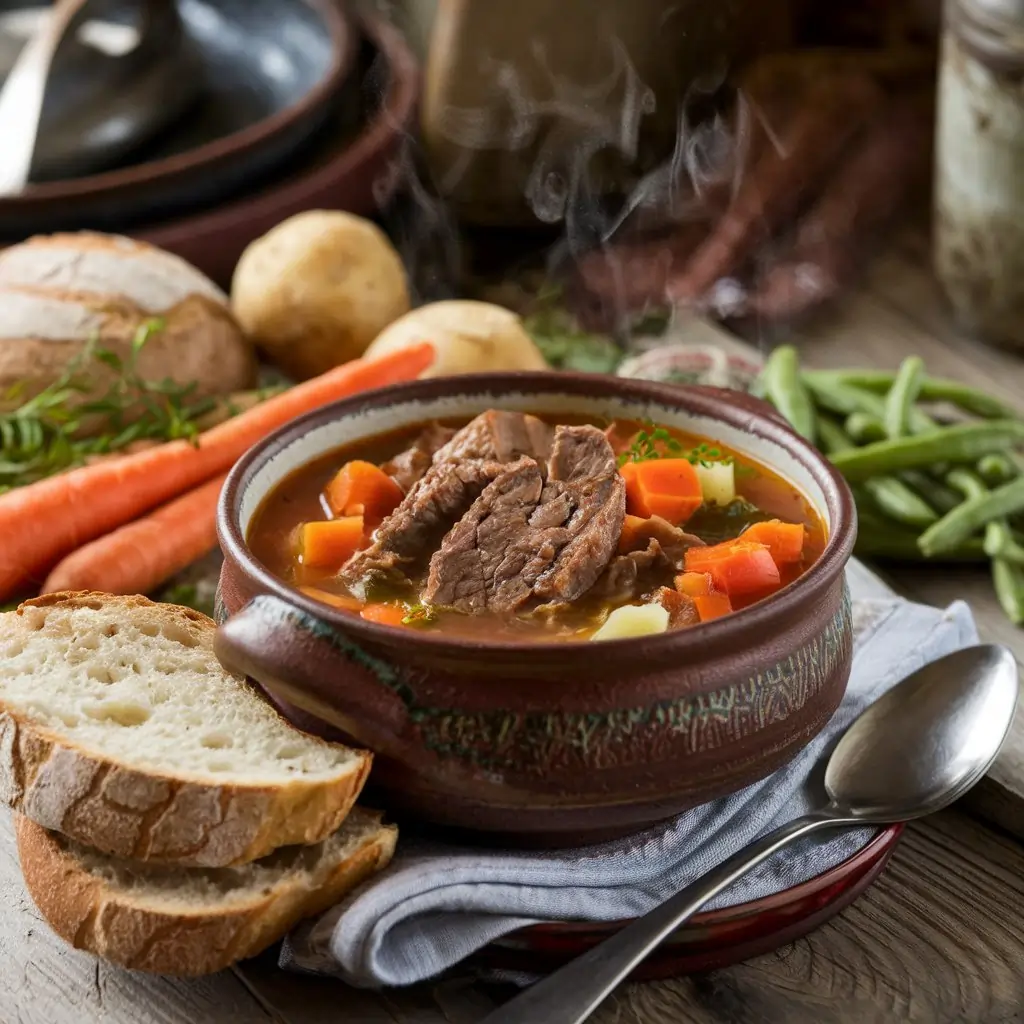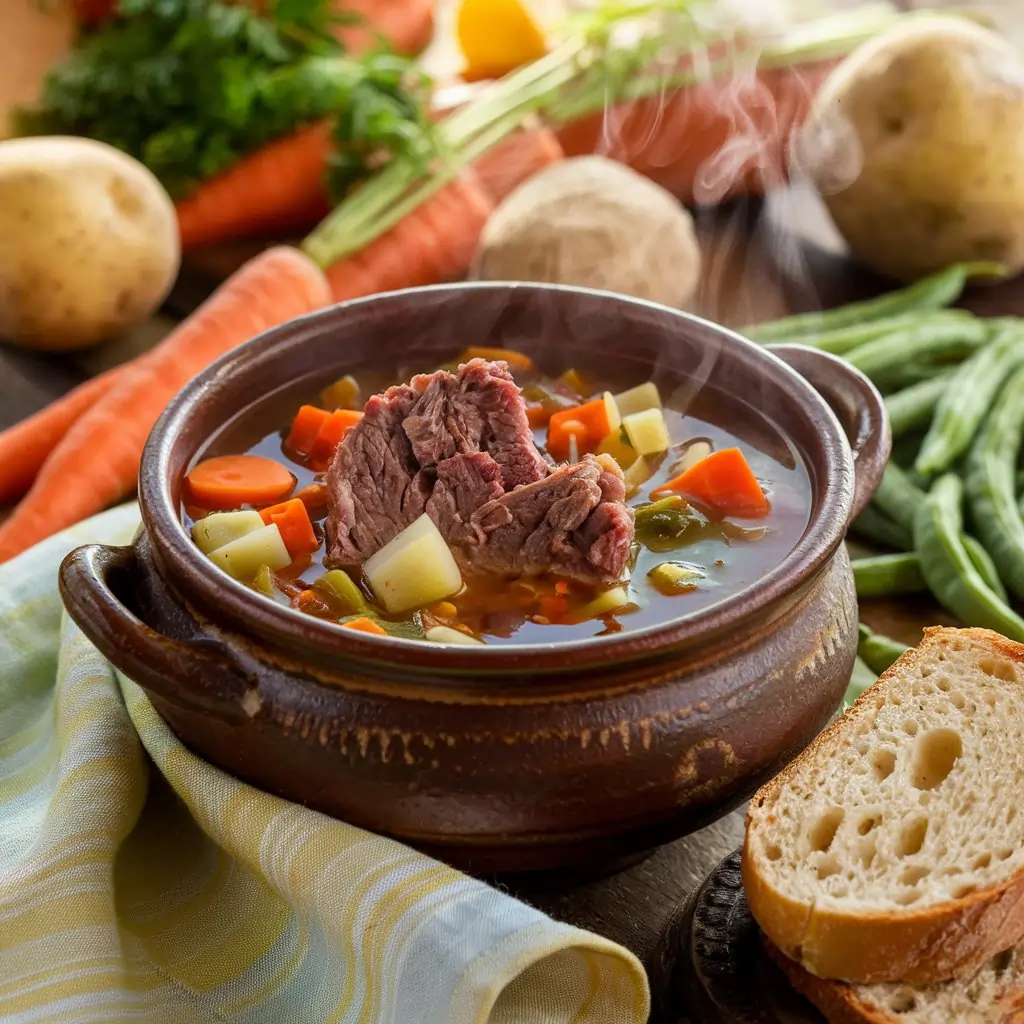Introduction
What’s better than a bowl of warm, hearty soup on a chilly day? Not much, especially when that soup is the best vegetable beef soup you’ve ever had! 🍲 This classic comfort food combines the richness of tender beef with the vibrant flavors of fresh vegetables, creating a dish that’s both satisfying and nutritious. Whether you’re cooking for your family, meal-prepping for the week, or simply craving something wholesome, vegetable beef soup is the perfect choice.
But what makes a soup truly the “best”? It’s all about balancing flavors, using the freshest ingredients, and avoiding common pitfalls. In this guide, we’ll break down everything you need to know, from picking the best beef cuts to avoiding mushy veggies. Ready to dive in? Let’s get cooking! 🥄
Table of Contents
What Makes the Best Vegetable Beef Soup?
Before we get into the recipe, let’s talk about what sets a great vegetable beef soup apart from the rest. It’s not just about tossing some meat and vegetables into a pot and hoping for the best. Oh no! The best soups are crafted with care, using:
- Old Fashioned Vegetable Beef Soup Recipe
- The Ultimate Guide to Vegetable Beef Soup
- Ground Beef Bulgogi Recipe
- High-quality ingredients for bold, fresh flavors.
- Perfectly cooked beef that’s tender and juicy.
- Vegetables with texture—not mushy or overcooked.
- A broth that’s rich and full-bodied, seasoned to perfection.
When you combine all these elements, you’re left with a bowl of soup that feels like a warm hug. 😊
Ingredients for the Perfect Vegetable Beef Soup
Selecting the Best Beef Cuts for Soup
Not all beef is created equal, especially when it comes to soups. For the best results:
- Chuck Roast: A popular choice because it’s marbled with fat, which adds flavor and tenderness as it cooks.
- Beef Shank: Known for its deep, beefy flavor and perfect for slow simmering.
- Short Ribs: If you’re feeling fancy, short ribs add an extra layer of richness.
💡 Pro Tip: Always trim excess fat but leave enough to enhance the broth’s flavor.
Must-Have Vegetables for Rich Flavor
Vegetables are the heart of this dish, and the key is variety:
- Root Vegetables: Carrots, potatoes, and parsnips add sweetness and texture.
- Green Veggies: Celery, green beans, and peas for freshness.
- Tomatoes: A few diced or crushed tomatoes give the broth a slightly tangy kick.
Adding Herbs and Spices for a Flavor Boost
Don’t forget the seasonings! Here are the MVPs:
- Bay Leaves: For depth of flavor.
- Thyme and Rosemary: Earthy herbs that pair beautifully with beef.
- Garlic and Onion: Essential for that classic soup base.
- Salt and Pepper: To taste—always season as you go.
Optional Ingredients to Elevate Your Soup
Want to get a little creative? Here are some optional add-ins:
- Barley: For a chewy, hearty texture.
- Red Wine: A splash can deepen the flavor of the broth.
- Parmesan Rind: Toss one in while simmering for a subtle, cheesy richness.
Step-by-Step Recipe: Crafting the Best Vegetable Beef Soup
Making the best vegetable beef soup doesn’t have to be intimidating. Follow these steps, and you’ll be a soup superstar in no time! 🌟
Preparation: Chopping and Searing Ingredients
Start with prepping your ingredients:
- Chop your vegetables into bite-sized pieces for even cooking.
- Cube your beef, trimming excess fat but keeping it in manageable chunks.
- Sear the beef in a large pot with a drizzle of oil until browned on all sides. This step locks in flavor and creates delicious caramelized bits on the bottom of the pot.
“Searing the meat is like the foundation of a house—get it right, and everything else will fall into place.”

Cooking Techniques: Achieving a Perfect Broth
A rich, flavorful broth is the backbone of any great vegetable beef soup. It’s where all the magic happens! Here’s how to create one that’s unforgettable:
- Deglaze the Pot: After searing the beef, pour in a cup of beef stock, red wine, or water. Use a wooden spoon to scrape up those flavorful brown bits from the bottom of the pot.
- Add the Aromatics: Toss in your chopped onions, garlic, and celery. Sauté until fragrant—this creates the foundation of your soup’s flavor.
- Layer the Liquid: Pour in beef stock, making sure it’s high-quality. You can use homemade stock or a store-bought option. For extra depth, add a can of diced tomatoes or tomato paste.
💡 Pro Tip: Use a combination of broth and water to avoid overpowering the soup with too much salt.
Simmering for Depth of Flavor
Simmering is where the magic happens. This step allows all the flavors to meld together into a harmonious blend:
- Bring to a Boil: Once all the ingredients are in, crank up the heat to bring the soup to a boil.
- Reduce to a Simmer: Lower the heat and let the soup simmer gently. This slow cooking process tenderizes the beef and infuses the broth with rich flavors.
- Skim the Fat: Occasionally skim off any excess fat or foam that rises to the surface.
“A good soup is like a symphony—it takes time for all the notes to come together into something beautiful.” 🎵
Adjusting the Seasoning and Final Touches
Taste-testing is a critical step. A bland soup can be salvaged with the right tweaks:
- Salt and Pepper: Add gradually, tasting after each addition.
- Acidity: If the soup feels flat, try a splash of vinegar or a squeeze of lemon juice.
- Fresh Herbs: Garnish with parsley, cilantro, or even a sprinkle of grated parmesan.
Common Mistakes to Avoid in Vegetable Beef Soup
Even seasoned cooks can fall into common traps when making soup. Here’s what to watch out for:
Overcooking the Vegetables
Nobody likes mushy vegetables! Add them in stages:
- Root Vegetables: These take longer to cook and should go in first.
- Green Vegetables: Add near the end to preserve their texture and color.
Using Low-Quality Meat
Cheap cuts of meat can turn chewy and unpleasant. Opt for cuts with marbling and cook them low and slow for best results.
Skipping the Browning Process
Never skip browning the beef—it adds a deep, savory flavor that takes the soup from “meh” to “wow!”
Variations of Vegetable Beef Soup
One of the best things about vegetable beef soup is how versatile it is. You can adapt it to suit your preferences or dietary needs:
Low-Carb and Keto-Friendly Versions
For a lighter option:
- Replace starchy vegetables like potatoes with cauliflower or zucchini.
- Use a bone broth base for extra nutrition.
Gluten-Free and Dairy-Free Options
Most vegetable beef soups are naturally dairy-free, but for gluten-free:
- Skip any barley or pasta.
- Check that your beef broth doesn’t contain gluten-based additives.
International Twists on the Classic Recipe
Add some global flair to your soup:
- Mexican-Inspired: Add cumin, chili powder, and a squeeze of lime.
- Asian-Inspired: Use ginger, soy sauce, and bok choy for a unique twist.
- Italian-Inspired: Incorporate oregano, basil, and a handful of small pasta shapes.
Health Benefits of Vegetable Beef Soup
Let’s not forget: this soup isn’t just delicious; it’s packed with nutrients!
Nutritional Value Breakdown
- Beef: Provides protein, iron, and essential amino acids.
- Vegetables: Loaded with vitamins, minerals, and antioxidants.
- Broth: Hydrating and rich in electrolytes.
How It Supports Immune Health
A bowl of vegetable beef soup is like a mini wellness retreat for your body:
- Garlic and Onion: Natural immunity boosters.
- Carrots and Tomatoes: High in vitamin C for a healthy immune system.
Aiding in Weight Management
Thanks to its high protein and fiber content, vegetable beef soup keeps you feeling full longer, making it a great choice for weight loss or maintenance.
FAQs
Even the best vegetable beef soup can leave cooks with a few lingering questions. Let’s tackle the most common ones to ensure your soup experience is flawless!
How Do I Store Leftover Vegetable Beef Soup?
Storing soup is easy if you follow these simple steps:
- Cool it Quickly: Let the soup cool to room temperature before transferring it to storage containers.
- Use Airtight Containers: Divide it into portions and store it in airtight containers to maintain freshness.
- Refrigerate or Freeze: Keep it in the fridge for up to 4 days or freeze it for up to 3 months.
💡 Pro Tip: When freezing, leave some space in the container for the soup to expand as it freezes.
Can I Freeze Vegetable Beef Soup?
Absolutely! Freezing is a fantastic way to preserve your soup for later:
- Best Practices: Avoid adding potatoes before freezing as they can become grainy. Instead, cook and add them fresh when reheating.
- Thawing: Defrost the soup in the fridge overnight or use the microwave for a quicker option.
“Freezing soup is like saving a hug for a rainy day—you’ll thank yourself later.” 😊
How Do I Reheat It Without Losing Flavor?
To reheat your soup:
- Stovetop: Heat it on low, stirring occasionally to prevent scorching.
- Microwave: Use a microwave-safe bowl and reheat in 1-minute intervals, stirring in between.
Always taste and adjust seasoning after reheating, as flavors may have muted over time.
Conclusion
There you have it—your ultimate guide to crafting the best vegetable beef soup! This recipe isn’t just a meal; it’s a comforting tradition, a nourishing pick-me-up, and a celebration of wholesome ingredients. From selecting the right beef cuts to layering flavors and avoiding common mistakes, you’re now armed with all the knowledge you need to create a soup that will wow your family and friends.
So, whether you’re ladling out bowls on a snowy evening or meal-prepping for the week, remember: soup isn’t just food—it’s love in a bowl. 🍲💖 Ready to try it out? Let us know how it turns out!

